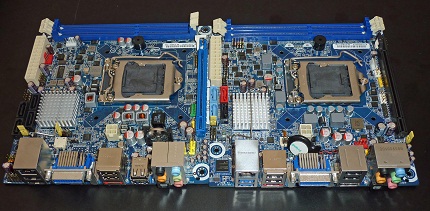IDF 2010: Upcoming Sandy Bridge CPU overclocks well
|
by Tarinder Sandhu
on 14 September 2010, 22:37
Tags:
Intel (NASDAQ:INTC)
Quick Link: HEXUS.net/qaz2w
Add to My Vault:
|
|
Intel demonstrated the upcoming Sandy Bridge microarchitecture at a benchmarking session during its annual developer forum. The chip company ran us through a bunch of tests that showed the desktop iteration of the Sandy Bridge CPU to be, on average, around 20 per cent faster than what was termed an equivalent Core i7 chip. The top-performing SB chips are based on a quad-core, eight-threaded design, much like current Lynnfield-based Core i7s, so the comparison is reasonably valid.
Being rather more coy with performance numbers than usual, Intel prohibited press from divulging the exact scores obtained from the Sandy Bridge processor. This seems rather strange in the face of publicly-available numbers published by a well-known website, but who are we to argue, right?
What we can tell you is that the 32nm Sandy Bridge chips overclock rather well, but you'll need to invest in a multiplier-unlocked K-series CPU to take advantage of the frequency headroom that exists in the part. This is because Intel's new architecture isn't partial to increases in the base clock - the simplest method used to overclock most current CPUs - as notching it up causes various linked clocks (GPU, for one) to be thrown out of kilter. Boo hoo!
Lots of headroom
Going by what we saw at the benchmarking session, Sandy Bridge K-series chips will scale better than current-generation Core i7 (LGA1156), to the tune of an extra 10 per cent. Do the maths and you can calculate the air-cooled speed without too many problems, we hope.
Punters looking to take advantage of these new chips will need a new motherboard, unfortunately, as Intel keeps the same mechanical socket but changes the pin layout from LGA1156 to LGA1155. The reason for the change - other than to extract more money from your pocket, no doubt - is, for one, to enable the graphics portion to output video correctly; it now has native DisplayPort connectivity.
Motherboard manufacturers will bring in the also-new 6-series chipset in with the Q1 2011 launch of the chips. They'll be thankful that physical changes between sockets are few and far between.
Examination of these tiddly boards shows that Intel won't be rolling USB 3.0 into the 6-series chipset; the right-hand board uses the ubiquitous NEC controller to provide SuperSpeed performance for the blue-coloured ports.
Intel's upcoming chips will provide roughly twice the graphics performance of present IGPs. They will also be available in low-TDP versions, making them suitably attractive as HTPC solutions. The real litmus test of the mainstream Sandy Bridge proposition will come when it's up against AMD's Fusion APU parts, and we wait for the showdown with bated breath.















